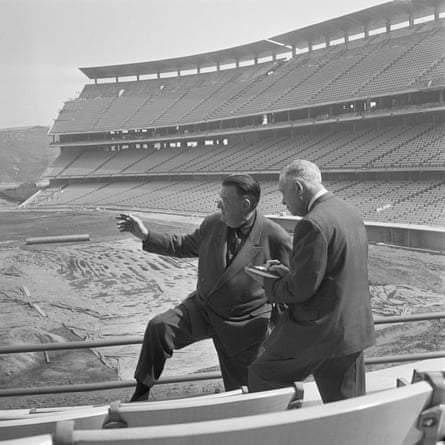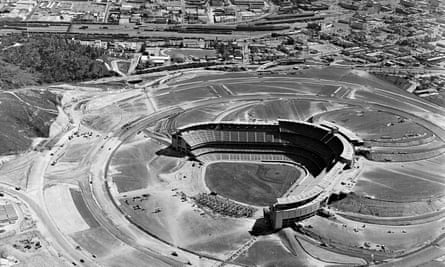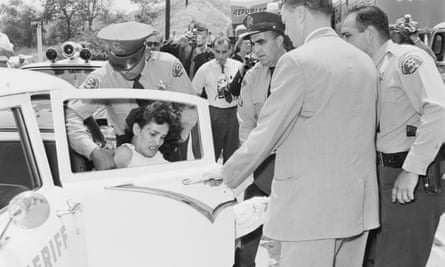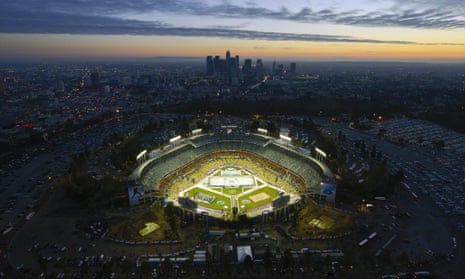On 10 April 1962, amid ceremony and celebration, Dodger Stadium, major league baseball’s modern showpiece, opened in Los Angeles. It was a day of pride and accomplishment for Walter O’Malley, the 58-year-old owner of the Los Angeles Dodgers, who had moved his team from New York in 1957 in order to build the ballpark of his dreams, one with every possible amenity and convenience. Now here it stood in the former Chavez Ravine neighbourhood, a beautiful setting overlooking downtown Los Angeles to the south and the San Gabriel Mountains to the north.
The city of Los Angeles also had reason to be proud. It had attracted the Brooklyn Dodgers, a storied and successful baseball franchise, with the promise of the finest stadium in America. Here it was, adorned in vibrant earth-to-sky colours, with unobstructed field views and the biggest and most technologically advanced scoreboard in the game. It was already being called the wonder of the baseball world, a grand civic monument befitting a world-class city. O’Malley, the Dodgers and Los Angeles had done it.
But at what cost? Between 1957 and opening day 1962, Dodger Stadium divided Los Angeles in deep and profound ways. It raised the question of the city’s modern identity: how would it best serve and govern its citizens? How would it present itself to the nation and world?
Opponents of the stadium objected to what they viewed as a giveaway of public property – the land at Chavez Ravine on which the stadium would be constructed – for the personal gain of a private individual, Walter O’Malley.

Supporters argued that the public benefits derived from the stadium in the form of property tax revenues, jobs, entertainment, and civic improvement justified O’Malley’s profits. They also envisioned Dodger Stadium as an important step in revitalising Los Angeles’s lacklustre downtown area and as one of the cultural amenities that marked the emergence of a sophisticated and modern city.
But stadium critics rejected the idea that a great American city required a central core studded with civic monuments. They argued instead for a Los Angeles that performed the basic tasks of urban life: concentrating tax resources on neighbourhoods in need of schools, streets, sanitation and safety. Dodger Stadium became the locus for an argument between those who envisioned Los Angeles as an everyday city of neighbourhoods and others who saw it as a modern, growth-focused city.
The struggle over Dodger Stadium made for unlikely political allies. Opposition to the Dodger contract united a white conservative Republican small businessman and a Latino Democrat on the Los Angeles City Council. Among the contract’s most ardent supporters, meanwhile, were the city’s mayor – the classic representative of business-oriented “Downtown” Republicanism – and a left-of-centre Democratic councilwoman from the downtown’s rival power centre, the Westside. What drove proponents and critics of the 1957 City Council ordinance providing for the transfer of publicly owned land at Chavez Ravine to the Dodgers for the construction of Dodger Stadium were as much cultural visions as political ones.
Perched on a hill only a mile from City Hall, Dodger Stadium would be the most significant addition to the downtown area in decades. By 1957, the year of the Dodgers’ arrival, downtown Los Angeles was a work-and-flee zone, a place in which white middle-class Angelenos earned a living by day and then abandoned at night. The city’s business establishment, notably the Chandler family of the Los Angeles Times, owned a substantial amount of real estate in the downtown area, and thus had much to lose from declining property values there; between 1920 and 1950, downtown’s share of the city’s retail trade had dropped from 90% to 17%.

Bunker Hill, downtown’s main residential neighbourhood, was home to a diverse working- and lower-class population. Municipal government officials, headquartered in the adjoining Civic Center, and downtown business and professional leaders, from their nearby offices, regarded Bunker Hill as an embarrassing eyesore. They viewed Dodger Stadium as the first step toward the revitalisation of downtown, which they envisioned in the image of more established cities – New York, Chicago, San Francisco – where downtowns combined commerce, culture, and leisure with middle- and upper- class residential neighbourhoods.
Los Angeles in the 1950s and 60s was a rapidly growing metropolitan area with an ambitious civic and business class eager for it to shed its provincial reputation and take on the attributes associated with the modern and with the more established American cities to which its members aspired. Dodger Stadium was the type of entertainment venue that modern cities possessed. It was the kind of civic venue that modern downtowns possessed.
Realising this desire would come at a cost in spending, tax revenues, land, housing and broken community bonds. These costs would largely be borne by others, notably minorities and working- and middle-class whites who opposed Dodger Stadium and with it LA’s rise to modernity.

In the neighbourhoods on the city’s peripheries, the defining issues concerned basic services – roads, schools, sanitation, police and housing. Here there were no great visions for Los Angeles’s downtown, only worries that their needs and their neighbourhoods would be sacrificed in the name of downtown’s rebirth.
Both racial and ethnic minorities in positions of social and economic disadvantage and those we are less accustomed to view as marginalized – white middle-class residents in peripheral areas of the city – felt cut off from the downtown area in the literal sense, living miles away with little geographic connection to it. But they also felt disconnected from what that area represented: the wealthy, the powerful, and the insiders whose successes and privileges seemingly had come at their expense.
The deal to build Dodger Stadium came to embody the anxieties of a diverse group of citizens. The long-standing, traditional Mexican American community at Chavez Ravine had started being uprooted in the early 1950s for a never-built public housing project. For Latinos, the construction of the stadium on that site engendered strong feelings of disempowerment and loss. The decade-long struggle by residents to remain on their land has gone into history as “The Battle of Chavez Ravine”.
The forced removal in 1959 of the last of Chavez Ravine’s families by sheriff’s deputies, televised live across the city, served as an impetus for the political and cultural radicalisation of the broader Latino community in the 1960s and beyond. Images of Aurora Vargas being carried out of the house on Malvina Street in Chavez Ravine in which her extended family had lived for 35 years and bundled into a Sheriff’s car, were published in every newspaper in Los Angeles. The day Vargas and her relatives were removed by the city of Los Angeles to clear the land for the construction of Dodger Stadium – May 8, 1959 – became known as a “day of infamy,” seared into the collective memory of LA’s Latino community. Descendants of los desterrados – “the uprooted” – continue to hold public remembrances of the Chavez Ravine evictions today.

The working- and lower-class residents of Bunker Hill who lost their dwellings to a massive redevelopment project that, like Dodger Stadium, was supported by Downtown political, business, and real estate interests were estranged from power centers whose offices they could see from their own windows. Even the middle-class white homeowners and small businessmen of outlying areas such as the rapidly growing San Fernando Valley had reason to resent the Downtown establishment, which spent their tax money on projects that redirected resources from their neighbourhoods.
All of these marginalised constituencies channeled their anger at perceived elites into the movement to stop Dodger Stadium from being built. A citywide referendum was held on 3 June 1958, after some 100,000 Los Angeles registered voters had signed petitions to place it on the ballot. Out of 677,000 votes cast, the result came within 25,000 votes of invalidating the contract that permitted the transfer of Chavez Ravine land to the Dodgers. That same year, two lawsuits challenging the legality of the contract succeeded at the trial court level, but were later reversed on appeal.
Protesters against the stadium picketed City Hall and jammed the galleries at raucous council meetings which they interrupted with boos and catcalls. Members of one of the evicted Chavez Ravine families, the Arechigas, publicly ripped up trespassing notices and pitched tents across from their demolished homes to dramatise their plight. The anti-Dodger Stadium movement, a cross-class and interracial massing of the marginalised, came tantalisingly close to success.
In the end, Dodger Stadium was built. Looming above LA’s downtown, it marks the spot where the modern city began. Downtown LA is now alive with luxury apartments, stylish stores and high-end eateries, as well as concert halls, arenas, museums, and some of the most expensive commercial real estate in the United States. The proponents of downtown modernisation and expansion in many ways got what they wanted. But the arguments surrounding it did not end on that gala opening day. The questions it raised about the relationship between public and private power, the respective roles of urban core and periphery, and the modern identity of Los Angeles itself would remain long after 10 April 1962. Dodger Stadium’s legacy is a city of contested dreams – past, present and future.
This is an edited extract from City of Dreams: Dodger Stadium and the Birth of Modern Los Angeles by Jerald Podair, published by Princeton University Press. Follow Guardian Cities on Twitter and Facebook to join the discussion, and explore our archive here

Comments (…)
Sign in or create your Guardian account to join the discussion